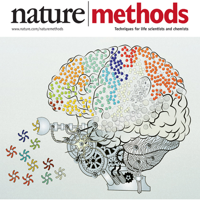Filter
Associated Lab
Associated Project Team
- Remove Tool Translation Team (T3) filter Tool Translation Team (T3)
- Transcription Imaging (1) Apply Transcription Imaging filter
Publication Date
Type of Publication
- Remove Janelia filter Janelia
3 Publications
Showing 1-3 of 3 resultsThe development of genetically encoded self-labeling protein tags such as the HaloTag and SNAP-tag has expanded the utility of chemical dyes in microscopy. Intracellular labeling using these systems requires small, cell-permeable dyes with high brightness and photostability. We recently discovered a general method to improve the properties of classic fluorophores by replacing N,N-dimethylamino groups with four-membered azetidine rings to create the "Janelia Fluor" dyes. Here, we describe the synthesis of the HaloTag and SNAP-tag ligands of Janelia Fluor 549 and Janelia Fluor 646 as well as standard labeling protocols for use in ensemble and single-molecule cellular imaging.
Pushing the frontier of fluorescence microscopy requires the design of enhanced fluorophores with finely tuned properties. We recently discovered that incorporation of four-membered azetidine rings into classic fluorophore structures elicits substantial increases in brightness and photostability, resulting in the Janelia Fluor (JF) series of dyes. We refined and extended this strategy, finding that incorporation of 3-substituted azetidine groups allows rational tuning of the spectral and chemical properties of rhodamine dyes with unprecedented precision. This strategy allowed us to establish principles for fine-tuning the properties of fluorophores and to develop a palette of new fluorescent and fluorogenic labels with excitation ranging from blue to the far-red. Our results demonstrate the versatility of these new dyes in cells, tissues and animals.
The century-old fluoresceins and rhodamines persist as flexible scaffolds for fluorescent and fluorogenic compounds. Extensive exploration of these xanthene dyes has yielded general structure–activity relationships where the development of new probes is limited only by imagination and organic chemistry. In particular, replacement of the xanthene oxygen with silicon has resulted in new red-shifted Si-fluoresceins and Si-rhodamines, whose high brightness and photostability enable advanced imaging experiments. Nevertheless, efforts to tune the chemical and spectral properties of these dyes have been hindered by difficult synthetic routes. Here, we report a general strategy for the efficient preparation of Si-fluoresceins and Si-rhodamines from readily synthesized bis(2-bromophenyl)silane intermediates. These dibromides undergo metal/bromide exchange to give bis-aryllithium or bis(aryl Grignard) intermediates, which can then add to anhydride or ester electrophiles to afford a variety of Si-xanthenes. This strategy enabled efficient (3–5 step) syntheses of known and novel Si-fluoresceins, Si-rhodamines, and related dye structures. In particular, we discovered that previously inaccessible tetrafluorination of the bottom aryl ring of the Si-rhodamines resulted in dyes with improved visible absorbance in solution, and a convenient derivatization through fluoride-thiol substitution. This modular, divergent synthetic method will expand the palette of accessible xanthenoid dyes across the visible spectrum, thereby pushing further the frontiers of biological imaging.

